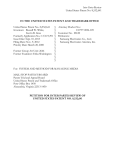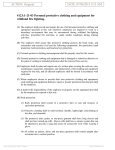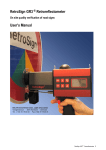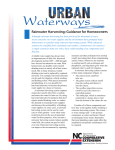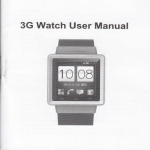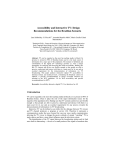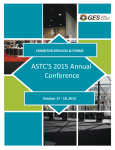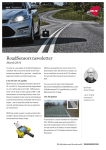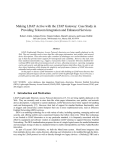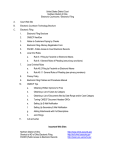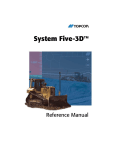Download Fall 2004 - Institute for Transportation Research and Education
Transcript
t r a n s p o r t a t i o n TRACKS Technology Transfer Newsletter published by the Local Technical Assistance Program (LTAP) at the Institute for Transportation Research and Education, North Carolina State University Retroreflectivity: Making Sure Signs Measure Up by Paul J. Carlson, PhD, P. E., Texas Transportation Institute What is Retroreflectivity? While all surfaces reflect light, the surfaces of traffic signs use an optical phenomenon called retroreflectivity to reflect light from vehicle headlamps back toward the driver. In general, the higher the retroreflectivity value of a sign, the better the sign returns light to the source. However, there are other factors such as viewing angle, headlamp aim, and driver characteristics that determine how bright the sign will actually appear to a driver. Therefore, it is important to check the performance of signs during both daytime and nighttime conditions. Periodic Inspections Necessary Over time, all retroreflective films will experience a loss in their performance. The sun’s rays, moisture, and pollutants cause a substantial amount of the retroreflective deterioration. Also, loss of retroreflectivity can also occur from vandalism such as paint ball shots, gunshots, spray paint, etc. Sign retroreflectivity can be evaluated by using one of the various retroreflectometers currently available or by nighttime windshield surveys. Regardless of the method used, each roadway should be checked at least once every two years. Desirably, each roadway would be checked annually. Information and descriptions of the currently available retroreflectometers can be found at the following Web sites: the devices that should be considered before an agency decides to make a purchase. There are at least two other viable methods to evaluate retroreflectivity. One is to develop a sign management system and replace signs at certain intervals depending on how long the retroreflective sheeting is expected to remain effective. Another method is conduct nighttime visual inspections. Nighttime Visual Inspections Nighttime visual inspections are probably the easiest and most commonly used way to check retroreflectivity. Research has shown that trained observers and sign maintenance personnel can adequately determine which signs need to be replaced (1-3). The following guidelines can be used when conducting a nighttime visual inspection: 1. The inspector must be knowledgeable about signing, and preferably should be at least 50 years old. As drivers age they need more light to see and their visual acuity decreases. In general, starting at the age of 20, a driver needs twice as much light every thirteen years. Therefore, a 72-year-old driver needs In This Issue . . . New Assistant LTAP Director, page 2 Software for Culvert Maintenance, page 5 North Carolina Transportation Forum 2005, page 6 Get the Picture! Page 7 continued on page 2 What’s wrong with this picture? • For the Impulse: http://www.pwsglobalinc.com/prod04.htm • For the Retrosign: http://www.flinttrading.com/retrosign.htm • For the 920 and 920SE: http://www.advancedretro.com/ • For the 920C: http://www.gamma-sci.com/930C retroreflectometer.htm The selection of retroreflectometers depends on the agency’s needs and budget. There are distinct advantages and disadvantages to each of Fall 2004 See page 7 to find out. Page 2 Transportation Tracks Program Notes Note from the Editor As many of you know by now, I have decided to leave ITRE to stay at home with my two girls. I have met a lot of people during our training workshops and at APWA events over the last fourteen years , and I have come to know many of you very well. Thanks for all the wonderful memories...I will miss you! Linda Collier has been hired as our new Assistant Director. She can be reached at (919) 515-7990 or by email: [email protected]. Please welcome her when you come to class! I hope our paths will cross again soon! Pam Cloer "Retroreflectivity" continued from page 1 16 times the amount of light that a 20-year needs (everything else being constant). This means that typically a young inspector will reject fewer signs than an older inspector. FHWA’s minimum retroreflectivity values are based on accommodating drivers at least 55-years old. 2. During inspections, a sport utility vehicle or pick-up truck should be used. Retroreflectivity reflects light back to its source — the headlamps. That means that signs look brighter the closer your eyes are to the headlamps. It follows that the inspection vehicle should be either an SUV or pick-up truck because the drivers’ eye is at a greater distance from the headlamps. FHWA’s retroreflectivity values will be based on the averaged dimensions of the top 10 selling SUVs, pick-up trucks, and minivans. When using a pick-up truck, it’s important that no heavy objects be located in such a manner that the headlamp beam pattern is altered. Loads should be distributed evenly for nighttime inspections. 3. Graphic courtesy of Avery-Dennison Reflective Film The inspection vehicle must have properly aimed headlamps. One of the most significant factors relating to how bright a sign looks at night is how much light is directed toward the sign. Since the light is coming from the vehicle headlamps, it is critical that the headlamps of the inspection vehicle be properly aimed. The survey vehicle should be checked by a qualified mechanic to make sure the headlamps are aimed properly (on low-beam). For documentation purposes, a record of the headlamp check should be made part of the sign inspection records. It’s also important that the mechanic check the voltage of the vehicle while running (at the battery terminals). Headlamp output is directly correlated with operating voltage. While the voltage will increase slightly during highway speeds as compared to idling, a good check is to have an idling voltage between 12.5 and 14 volts. Both the headlights and the windshield must be clean during the inspection. 4. Use low beams only. Most nighttime driving is done with low beams. It is important that nighttime inspections be conducted with low-beam headlamps only. Inspectors should not flash their high-beam lights at marginal signs. 5. Document the entire procedure. The development and subsequent introduction of minimum retroreflectivity values will undoubtedly increase an agency’s liability concerns. It is critical that an agency be able to demonstrate that they are implementing the minimum retroreflectivity values to reasonably ensure nighttime visibility. Documentation is critical. Types of recording systems include the following: • Passenger recorder This method involves two personnel, which adds costs but also adds another set of eyes. The passenger records the signs that need attention. The method utilizes pen and paper and the forms are maintained for future use. • Tape recorder As the inspector drives down each road, he/she makes narrative comments about the signs. The level of detail could vary from just mentioning those that need attention or it could include all signs, regardless of their condition. The tapes are maintained for future use. continued on page 7 Calendar of Events Page 3 Transportation Tracks November 3: 16: NCAPWA Construction Inspection Workshop Trenching “Competent” Person Training ITRE-Raleigh (919) 515-8033 November 30-December 2, 2004 Raleigh, NC Snow & Ice Control ITRE-Raleigh (919) 515-8033 17: Snow & Ice Control ITRE-Charlotte (919) 515-8033 18: Surveying Methods for Local Highway Departments ITRE-Raleigh (919) 515-8033 30: Unpaved Road Maintenance ITRE-Raleigh (919) 515-8033 Conferences/Events NC Transportation Forum 2005 March 23-24, 2005 Charlotte, NC www.nctransportationforum.org Southeastern Local Roads Conference April 3-5, 2005 LTAP, Savannah, GA (404) 656-4664 December 1: Motorgrader Equipment Operator Training ITRE-Raleigh (919) 515-8033 14: Basic Work Zone Safety ITRE-Asheville (919) 515-8033 15: Intermediate Work Zone Safety ITRE-Asheville (919) 515-8033 16: Advanced Work Zone Safety ITRE-Asheville (919) 515-8033 17: Flagger Training ITRE-Asheville (919) 515-8033 Charlotte Construction Expo The Greatest Show in Construction, Public Works & Landscaping December 1-2, 2004 Cabarrus Arena & Events Center Concord, NC For more information visit the conference Web site at: http://www.cegltd.com/pages/ tradeshows/char.asp The objectives of this program are to introduce the basic concepts of construction inspection to public works inspectors. Topics include: discussing the role of the inspector in public works construction projects; duties, record keeping and interpreting contract documents; inspecting underground conduit construction; understanding the fundamentals of soils, soils classifications, soil compaction, control of embankments, subgrades and stabilizing soils; understanding the fundamentals of concrete; understanding the fundamentals of asphaltic concrete, raw materials, mixed design and construction of asphaltic concrete; and other issues related to construction inspection. This program is designed for construction inspectors and supervisors of construction inspection (entry level; 1-5 years experience). The new, potential, and experienced construction inspector or supervisor will benefit from the presentation of principles and practices of construction inspection. For more information on this workshop, please contact Linda Collier at (919) 515-7990 or [email protected]. 2005 LTAP Schedule We are currently working on the Spring 2005 training schedule. If you'd like to host a workshop or if you have suggestions for new courses, please contact Linda Collier at (919) 515-7990 or [email protected] as soon as possible. Page 4 Transportation Tracks Useful Information Library Loan Materials Library materials are available for loan by contacting Ronnie Williams at (919) 515-8033 or [email protected]. Alerting Motorists to Turns and Curves Ahead NV LTAP Street Wise How to choose and place warning signs and delineators to help guide motorists through turns and curves. NCTROADS: The Answer to Some of Your Problems Interactive Highway Safety Design Model FHWA CD-ROM Road safety evaluation software that marshals available knowledge about safety into a more useful form for highway planners and designers. NCTROADS is an electronic computer discussion group (also known as “listserv”) dedicated to the improvement of networking and information exchange among North Carolina Transportation professionals. Recommended Use of Reclaimed Asphalt Pavement in the Superpave Mix Design Method NCHRP CD-ROM Research developed guidelines for incorporating reclaimed asphalt pavement (RAP) in the Superpave system. NCTROADS provides a computerized forum for federal, state, and local government transportation employees to share information and ideas. The listserv is an informal network for the exchange of news about current research, discussion of problems and solutions, requests for advice and assistance, and announcements of upcoming conferences and events. Roadway Safety Tools for Local Agencies Transportation Research Board (TRB) Aids local government agencies as they select tools and develop programs to implement road and street safety improvements. Video Profile It’s About Time…Traffic Signal Management Cost Effective Street Capacity & Safety FHWA (13 Minutes) This videotape demonstrates how signal timing on roads can improve air quality while reducing fuel consumption, decreasing traffic congestion, and saving time for commercial and emergency vehicles. It also shows that retiming can reduce aggressive driving behavior and the number of severe accidents. Making Safer Roads Insurance Institute for Highway Safety (12 Minutes) More than one in four motor vehicle deaths on U.S. roads do not involve a collision with another vehicle or vehicles. It involves hitting a roadside hazard like a tree, utility pole, or bridge support. Such crashes are a problem especially on secondary roads, which still are cluttered with roadside hazards while interstates have been improved. In this videotape, experts explain which hazards present the worst problems. They tell how to alleviate the hazards. These aren’t problems that can be removed all at once because the solutions often are costly, but there are common-sense approaches to the hazards along the roadside. Protecting Our Pavements: Preventive Maintenance FHWA/Michigan DOT (14 Minutes) This videotape illustrates cost-effective treatments to decrease pavement deterioration on existing roadways. • Are you a public works, streets or NCDOT employee? • Have you ever faced a problem or a need and thought, “There must be a simple solution to this. I wonder if somebody else figured it out.” • Do you want to learn more about upcoming conferences and events? • Do you want to learn more about current research and innovative products developed by other local government employees? • Do you need help with a particular problem from another transportation professional? • Do you want to learn more about safety? If you answered “yes” to any of the questions above, then you need to subscribe to NCTROADS... it’s easy and free! To Subscribe: • Send an email message to: [email protected]. • Leave the subject line of the email blank. • In the body, type: subscribe NCTROADS and your email address. • Do not send a signature with this message. To Post A Message: (after you subscribe) • Send an email message to: [email protected] Resources New Software Helps Agencies Track Culvert Maintenance Malfunctioning culvert can contribute to flood damage on roads and bridges, but tracking the need to maintain and replace culverts before they cause problems can be a challenge for local road agencies. Many rely on manual systems to record information on inventory, condition, and work needs, which can be time-consuming and inefficient. Other agencies have no formal system in place and consequently find themselves reacting to immediate or impending problems, rather than proactively managing maintenance and replacement. To help agencies manage their culvert inventories, condition assessments, and improvement programs, the Federal Highway Administration (FHWA), under the Local Technical Assistance Program (LTAP), developed a computer-based “Culvert Management System.” Designed to help transportation professionals responsible for local road maintenance save time and money, the system provides an automated tool to facilitate the coordination of culvert maintenance and replacement operations on a systemwide basis. The software enables agencies to create an inventory of their culverts, assess them, and schedule repairs and replacements. It also helps agencies to develop maintenance plans and to estimate costs for installing, repairing, or replacing culverts. The system consists of five modules, which an agency can phase in individually. The inventory module enables the agency to record information about each culvert under its jurisdiction, such as size and location, while the condition module maintains a record of each culvert’s condition. The schedule module helps the agency develop a culvert work plan for the year. The work needs module enables the agency to define maintenance and rehabilitation options, determine costs, and rank work by type and priority. With the work funding module, agencies can project culvert deterioration over time and develop long-term work programs. In addition, agencies can use the system to analyze the type and size of pipe used in individual culverts. By comparing the different types of pipe used, the agency can determine if certain culverts require more frequent maintenance or are more costly to repair, leading to specifications for pipe replacement and installation. The system’s user manual cites an example of a local agency using the software to determine that a minimum pipe size of 457 millimeters (18 inches) in diameter would reduce the frequency and effort required to maintain a culvert. Copies of the software and user manual are available from the FHWA Report Center by calling (307) 577-0818. Reprinted from the Research & Technology Transporter (FHWA), February 2004.) FHWA’s Role in Surface Transportation Security FHWA Operations is engaged in emergency preparedness and management, working with other DOT administrations and Federal agencies, its State and local partners, academia, industry associations, and the private sector. The purpose is to ensure that surface transportation operating agencies throughout the nation have the necessary tools, techniques, information, and understanding to be able to prevent when possible, prepare for, respond to, and recover from both natural and man-made disasters. A key element is “emergency transportation operations preparedness.” For more information on FHWA’s role in surface transportation security and to print the brochure, “Public Safety & Security Program”, visit www.ops.fhwa.dot.gov/opssecurity/ Highway Users Alliance Launches New Web Site and Announces the SmartRoads Challenge Traffic congestion, roadway safety, and highway funding affect everyone. We know that people are concerned about the policies governing the billions of dollars in funding for our national highway system. So to keep you informed, the American Highway Users Alliance is launching a far-reaching resource to ensure that the latest developments in transportation are just a mouseclick away. Page 5 Transportation Tracks We invite you to bookmark the American Highway Users Alliance’s new Web site www.highways.org. This site is a cuttingedge, informative resource that we believe will serve as the source of information and insight on America’s highways. Complete with the latest news, legislative updates, and challenges effecting our highway safety and mobility, this new site is a helpful tool that will introduce you to the Highway Users and keep you up-todate on important transportation news. Learn about why we need highways. Discover the hot issues facing the transportation community today, and be sure to sign up for our weekly e-mail news update. All of these features are geared toward providing you with a strong knowledge of today’s transportation issues, as well as equipping you with the tools you need to participant in the debate. GIS in Transportation The GIS in Transportation Web site (www.gis.fhwa.dot.gov/) highlights innovative transportation-related applications of GIS across the country. Kids and Public Works PWPaws.net is an exciting, new educational tool developed by APWA to help introduce children to public works. http://www.pwpaws.net/ We urge you to take time to visit PWPaws.net and explore the outreach tools there. The age-appropriate educational activities for elementary, middle and high school students range from simple mazes to in-depth environmental information for socially conscious teens. Also available on the site is the acclaimed public service announcement video entitled: “Everyday Heroes. This 6 minute look into the value and breadth of public works is sure to make a hit whenever it is shown. Center and Edge Line Pavement Markings This article describes the MUTCD rules for centerlines and edge lines. www.T2.unh.edu/fall03/pg2.html. Page 6 Group News Transportation Tracks NC Transportation Forum 2005 On March 23-24, 2005 the North Carolina transportation industry will come together in Charlotte for the first North Carolina Transportation Forum. The Forum will provide an opportunity for all North Carolina organizations associated with the transportation industry to come together to get to know one another better, to better understand each representative organization’s role in the transportation system of our state, provide a common forum to further the interest of the transportation industry, and provide educational opportunities to further each group’s understanding and knowledge of important issues facing our state. At this time we have 16 organizations committed as Forum members representing over 1000 transportation professionals in the state. Professional Engineering Classes to be Held at ITRE Professional Engineering Review Course ($670) The PE Review class will be taught on alternating Fridays (9AM-5PM) and Saturdays (8AM-4PM) for 8 weekend sessions. Classes begin November 5 and run through March 12. Professional Engineering Night Review Course ($565) The PE Night Review class will be taught on Wednesdays from 6PM-9PM for 19 nights. Classes begin on November 3 and run through March 30. Fundamentals of Engineering Review Course ($735) The FE Review class will be taught on alternating Fridays (9AM-5PM) and Saturdays (8AM - 4PM) for 10 weekend sessions. Classes begin on October 29 and run through March 19. Fundamentals of Engineering Night Review Course ($620) The FE Night Review class will be taught on Tuesdays from 6PM-9PM for 22 nights. Classes begin October 26 and run through April 5. All classes will be held at ITRE’s training facility in Raleigh: Institute for Transportation Research and Education North Carolina University Centennial Campus 909 Capability Drive, Research Building IV Room 2600 Raleigh, NC 27606 The Forum will provide each participate with the opportunity to hear our keynote speakers address important issues facing the North Carolina transportation industry, attend technical sessions to further educate yourself on important transportation issues, enjoy a time socializing with a wide range of fellow transportation industry participates, and relax and enjoy the entertainment at the Dinner Banquet. There is no prorating of course fees. Each participant will receive a course notebook (yours to keep) and additional textbook materials will be available for purchase. All meals and any necessary lodging expenses are the responsibility of each participant. For more information, contact Christie Vann at (919) 515-8767. For more information contact Calvin Leggett, Conference Chair at (919) 733-2031 or [email protected] or contact Tom Goodwin, Vice Chair at (919) 782-4155 or [email protected]. Save the Date! www.nctransportationforum.org Visit http://www.itre.ncsu.edu/highways/profdev.html for a complete schedule and registration information. The 2004 NCSITE Annual Meeting will be held December 2, 2004 at the Raleigh Convention Center. Mark your calendar and plan to attend. http://www.itre.ncsu.edu/ncsite/NCSITE.html Upcoming APWA Click, Listen and Learn Programs The American Public Works Association (APWA) audio-web conferences offer a new, cost-effective way of learning and sharing information through the use of the tools sitting on your desk: a telephone and a PC with web access. Listen to the speakers through your telephone, and view the visual presentation via the web. Programs average two hours in length, feature live Q&A, and include printed speaker handouts. Participate from your desk, or in a group setting by connecting through a conference/speaker phone and projecting the web image upon a screen. The total fee is $150.00 per site…divide that by the number of individuals in attendance and you have a bargain! November 17: Innovative Ideas for Sidewalk Management December 9: Workplace Safety December 16: Stream Restoration Page 7 Retroreflectivity • • Video recorder A video in the vehicle is perhaps one of the most efficient ways to document a nighttime inspection. The inspector should supplement the video by using the audio recording capabilities and recording his/her assessment of the signs. The videos are maintained for future use. Combinations and other methods. There are numerous combinations to these basic approaches. All methods of recording require that the inspector be able to recognize a deficient sign. One means of accomplishing this is as follows: • • 6. The agency would assemble a set of signs that barely satisfy threshold conditions of acceptability (minimum numerical retroreflectivity values to be referenced by FHWA). A retroreflectometer could be used to measure the retroreflectivity of the selected signs. Before each nighttime inspection, the inspector would set these signs up in their maintenance yard and evaluate them with the inspection vehicle. This procedure allows the inspectors to train, or “calibrate” their eyes to identify threshold conditions of acceptability. (And, during the inspection, the dome light should not be used, as this could impact the inspectors’ nighttime visibility. Instead, they should use small flashlights with red, green, or blue lenses, or they should use pens with small lights inside.) Safety is of utmost importance during the inspection. One of the advantages of the nighttime visual inspection method is that it minimizes the need to stop along the side of a road to evaluate a sign. The inspection should be conducted at normal highway speeds. However, if there is a need to take another look at a particular sign, the inspector should turn around and drive past the sign at highway speeds once more. If there is still question about a feature of the sign other than retroreflectivity, the inspector should make a note and revisit the sign location during the day. Transportation Tracks nighttime sign inspections should not be conducted when water has condensed on the sign surface or during rain or fog conditions. References 1. A general rule-of-thumb for conducting nighttime sign inspections is, “When in doubt, throw it out.” It is also important to note that 2. 3. Hawkins, H.G. and P.J. Carlson. Sign Retroreflectivity: Comparing Results of Nighttime Visual Inspections with Application of Minimum Retroreflectivity Values. In Transportation Research Record 1754, Transportation Research Board, National Research Council, Washington, D.C., 2002. E.A. Lagergran. Traffic Sign Retroreflectivity Measurements Using Human Observers. Report No. WA-RD 140.1, Washington State Transportation Research Center, Seattle, WA, 1987. Ziskind, D., D. Mace, L. Staplin, J. Sim, and K. Lococo. Minimum Visibility Requirements for Traffic Control Devices. FINAL REPORT, Contract No. DTFH61-87-00008, Ketron, Inc., Malvern, PA, 1991. (Reprinted with Permission from Texas LTAP’s Lone Star Roads, Jan-Feb 2003) Get the Picture! by Timothy B. Baughman, PE ITRE’s Highway Operations and Safety Manager So what’s wrong with the picture? Isn’t a Signal Ahead warning sign supposed to have a yellow background? True, warning signs normally have a yellow background. However, when used in a work zone, the background color changes because orange is supposed to encourage drivers to watch out for workers and equipment in or near the road. There are two problems with the picture, though. First, the sign is upside down. Signal Ahead warning signs, whether permanent or used in temporary traffic control, replicate a real signal with the red bulb on top and green on bottom. The other problem is less obvious in this photo. The traffic signal for this haul-road crossing isn’t yet operational and the signal heads are bagged. So why have the signal warning signs been installed? As commuters travel this road day in and day out and see these signs, will they react when the signal is activated? Inappropriate work zone warning signs, such as flagger ahead or lane closed signs, need to be covered, turned away, or removed when nothing is going on so that motorists are not mislead. These Signal Ahead warning signs need to be covered as well. If you have any questions or comments about worker safety and work zone traffic control, give me a call at (919) 515-8654, or email me at [email protected]. Page 8 Transportation Tracks Back Tracks To request a copy of any of the materials listed below, check the items you want and mail this form to Ronnie Williams, ITRE, NC State University, Centennial Campus, Box 8601, Raleigh, NC, 27695-8601. Email your requests to [email protected], or fax your request to (919) 515-8897. Materials are distributed on a first-received, first-ordered basis. There is no charge for these materials. 2004 Videotape Lending Library Catalog NC LTAP Picking the Proper Glove ToolBox Topics 2004 Workplace and Equipment Safety Fact Sheet Kansas LTAP (25 pages) Scaffold Inspections ToolBox Topics Chain Saw Safety ToolBox Topics When a Hurricane is Coming ToolBox Topics For more information about our Technology Transfer Center, refer to our Web site: www.itre.ncsu.edu/LTAP Publication Statement Transportation Tracks is published quarterly by the North Carolina Technology Transfer Center at the Institute for Transportation Research and Education (ITRE), North Carolina State University (NCSU), in cooperation with the North Carolina Department of Transportation (NCDOT) and sponsored by the Federal Highway Administration (FHWA) through its Local Technical Assistance Program (LTAP). Center staff include: James B. Martin, P.E., Director; Linda Collier, Assistant Director and Newsletter Editor; and Ronnie Williams, Program Assistant. To be added to the mailing list or to submit articles for the newsletter, contact the center at ITRE: NCSU Centennial Campus, Box 8601, Raleigh, NC, 27695-8601. Phone: (919) 515-8899. Fax: (919) 515-8897. Web site: www.itre.ncsu.edu/ltap . Address correction requested. Any opinions, findings, conclusions, or recommendations expressed herein are those of the author(s) and do not necessarily reflect the findings, policies, or procedures of ITRE, NCSU, NCDOT, or FHWA. FIRST CLASS transportation TRACKS North Carolina Technology Transfer Center Institute for Transportation Research and Education North Carolina State University Centennial Campus Box 8601 Raleigh, NC 27695-8601 TRACKS t r a n s p o r t a t i o n














